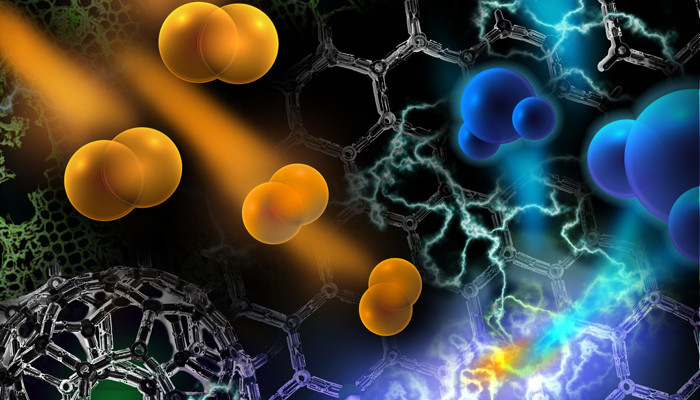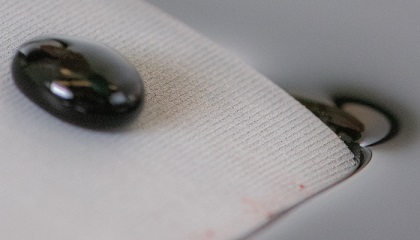Advanced Materials highlights Finnish materials science
Advanced Materials, a premier journal in the field, has dedicated an issue to Finnish research, covering several articles from Aalto University.

The weekly peer-reviewed scientific journal covers reviews, progress reports, communications, and research news at the cutting edge of the chemistry and physics of functional materials. The special issue dedicated to Finnish functional materials science displays the following topics from the researchers of Aalto University.
Fuel cells and novel energy storage and conversion devices have potential benefits in addressing climate change. One of the major challenges in fuel cells is obtaining more economical electrocatalysts without compromising activity and durability. Sustainable and abundant biomass resources have been proposed as alternative precursor in such systems. In the article “Advanced Biomass‐Derived Electrocatalysts for the Oxygen Reduction Reaction” researches provide an overview on recent biomass‐derived electrocatalysts for the oxygen reduction reaction (ORR). The ORR plays a significant role in the performance of numerous energy‐conversion devices. According to the article, there is a great promise in the integration of biomass‐derived nanomaterials in energy‐conversion devices.
In DNA nanotechnology, DNA molecules can be utilized as a high-capacity information storage, and interestingly, used as construction material to assemble accurate, biocompatible and functional nanostructures for diverse applications in biology, chemistry and physics. Progress Report "Evolution of Structural DNA Nanotechnology" summarizes how the nanostructures have recently evolved together with powerful design and simulation software. Simultaneously they have provided a significant expansion of the shape space of the nanostructures. Today, researchers can select the most suitable fabrication methods and design paradigms – DNA origami and the related techniques particularly emphasized in this report – and software from a variety of options when creating unique DNA nanoobjects and shapes for an excessive amount of implementations in materials science, optics, plasmonics, molecular patterning and nanomedicine.
 “Superhydrophobic Blood‐Repellent Surfaces” provides the reader with the current understanding of the potential of micro‐ and nanostructured superhydrophobic (SHB) surfaces for blood‐compatible medical devices. Superhydrophobicity is achieved by surface roughness at the nano‐ and/or microscale combined with low‐surface‐energy chemistry, typically by hydrocarbon or fluorocarbon coatings. Blood is a challenging liquid to repel due to its high propensity for activation of intrinsic hemostatic mechanisms, induction of coagulation, and platelet activation upon contact with foreign surfaces. Imbalanced activation of coagulation drives thrombogenesis, formation of blood clots, that can occlude the blood flow or expose tissues to ischemia and infarction. Blood‐repellent superhydrophobic surfaces aim toward reducing the thrombogenicity of surfaces of blood‐contacting devices and implants.
“Superhydrophobic Blood‐Repellent Surfaces” provides the reader with the current understanding of the potential of micro‐ and nanostructured superhydrophobic (SHB) surfaces for blood‐compatible medical devices. Superhydrophobicity is achieved by surface roughness at the nano‐ and/or microscale combined with low‐surface‐energy chemistry, typically by hydrocarbon or fluorocarbon coatings. Blood is a challenging liquid to repel due to its high propensity for activation of intrinsic hemostatic mechanisms, induction of coagulation, and platelet activation upon contact with foreign surfaces. Imbalanced activation of coagulation drives thrombogenesis, formation of blood clots, that can occlude the blood flow or expose tissues to ischemia and infarction. Blood‐repellent superhydrophobic surfaces aim toward reducing the thrombogenicity of surfaces of blood‐contacting devices and implants.
There is an emerging quest for inexpensive and lightweight materials with excellent mechanical performance. In the article “Advanced Materials through Assembly of Nanocelluloses” researchers review recent processes and a wealth of functionalization routes to make nanocelluloses as a sustainable solution to these challenges. Nanocelluloses are presented as versatile platforms for controlled structures and tailored properties for a range of applications, from rheology control to tissue engineering scaffolds, some of which are already entering in the market. Flexible devices and sensors based on nanocellulose are demonstrated, taking advantage of its transparency and other properties. By carefully engineering plant-based resources, especially nanocelluloses, a major impact in the sustainable energy sector, high tech clothing and 3D printed materials is expected.
Nonlinear optics is a key enabling technology of our modern society, such as in imaging and high-speed data communication. The article ”Nonlinear Optics with 2D Layered Materials“ displays how extraordinarily strong nonlinear optical response in graphene-like materials could be used for various photonic and optoelectronic applications. The researchers also discuss several possible future research directions of various atomically thin materials and their hybrid heterostructures. It is anticipated that the current state of the art results in the relevant fields can potentially lead to a new generation of nonlinear photonic devices for a broad range of applications, for example, micromachining and microsurgery, sensing and imaging and quantum technologies.
Photo: Valeria Azovskaya
Advanced Biomass‐Derived Electrocatalysts for the Oxygen Reduction Reaction
Maryam Borghei, Janika Lehtonen, Liang Liu, Orlando J. Rojas
First published: 4 December 2017
https://doi.org/10.1002/adma.201703691
Evolution of Structural DNA Nanotechnology
Sami Nummelin, Juhana Kommeri, Mauri A. Kostiainen, Veikko Linko
First published: 24 January 2018
https://doi.org/10.1002/adma.201703721
Superhydrophobic Blood‐Repellent Surfaces
Ville Jokinen, Esko Kankuri, Sasha Hoshian, Sami Franssila, Robin H. A. Ras
First published: 21 February 2018
https://doi.org/10.1002/adma.201705104
Advanced Materials through Assembly of Nanocelluloses
Eero Kontturi, Päivi Laaksonen, Markus B. Linder, Nonappa, André H. Gröschel, Orlando J. Rojas, Olli Ikkala
First published: 5 March 2018
https://doi.org/10.1002/adma.201703779
Nonlinear Optics with 2D Layered Materials
Anton Autere, Henri Jussila, Yunyun Dai, Yadong Wang, Harri Lipsanen, Zhipei Sun
First published: 25 March 2018
https://doi.org/10.1002/adma.20170596


